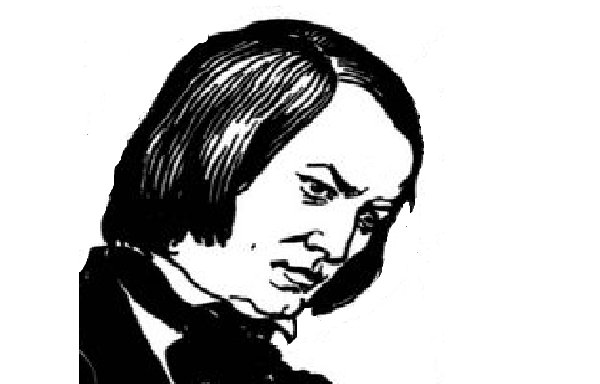|
|
||
|---|---|---|
|
|
|
|
|
|
||
1810 |
Robert Schumann is born on June 8 in Zwickau, a town of then about 5000 inhabitants in the German kingdom of Saxony, situated 90 km south of Leipzig (= Leipsic*). He is the fifth child, the fourth son of the bookseller and publisher August Schumann and his wife Christiane, née Schnabel. The family is financially quite well off: the publication of several trade journals and magazines proves profitable as does that of inexpensive editions of the classics. A particular success is August Schumann’s translation of Childe Herold’s Pilgrimage by Lord Byron. Robert’s father is an author himself and writes works in the taste of the time such as Junker Kurt von Krötensteins verliebte Heldenfahrt (The Amorous Exploits of Squire Kurt von Krötenstein). * The names of the cities given in blue are found on the contemporary map to the right as they are written in brackets. Little Robert loves his quiet and diligent father; he is also much attached to his mother and suffers with her through her bouts of depression. Frédéric Chopin is born in the same year in Želazowa Wola/Poland. |
|
1817 |
Robert attends a private primary school that teaches, among other subjects, Greek, Latin and French to students even at this tender age. He also takes piano lessons with the organist Johann Gottfried Kuntsch. |
|
1820 |
At the age of ten, Robert is sent to a Lyceum (a type of secondary school). He reads a lot, helps his father wherever he can, e.g. with proof-reading, and gets to know the great masters of German literature. His high-strung mind prefers the romanticists Jean Paul, Novalis and Hölderlin. |
|
1823 |
The opera Der Freischütz by Carl Maria von Weber, performed at the inauguration of Zwickau’s new theater is a significant event for the youngster. He writes much later in life that it was then that he decided to devote himself to music. The father is pleased with his son’s virtuosity at the piano (who, however, is never considered a Wunderkind) and buys him a grand piano built by the Vienna firm of Johann Andreas Streicher. Robert organizes and directs a student orchestra that often performs in the house of the Schumanns. |
|
1825 |
In October, Robert’s 29-year-old sister Emilie takes her own life, probably in a phase of depression because of a disfiguring skin disease. |
|
1826 |
Besides his interest in music, the active young man finds time for literature: he sets up and runs a club for friends of the arts offering soirees with recitals of all kinds. It is probably here that he presents his adaptation of the sonnets by Petrarca or parts of his translations of the works by Horaz and Homer. At this time already he is much in demand as a pianist and his talents of playing prima vista and for improvisation are widely praised. This is a sad year for the Schumann family: the beloved father dies in August from pulmonary tuberculosis at age 53. His last will prescribes that the fifth of his fortune going to Robert is to be used for his education, that is the considerable amount of 12,000 Taler (in 2010, one Taler would have the purchasing power of about 30 € or 43 US$). The composer Carl Maria von Weber, a cousin of Constanze Mozart and an idol of Robert’s, also falls victim of the then raging tuberculosis at the age of only 39 years. |
|
1827 |
At a party, Robert Schumann makes the acquaintance of Agnes Carus, the young wife of the professor of medicine and court councillor Carl Gustav Carus. She sings Lieder by Franz Schubert, Robert accompanies her at the piano and falls in love with her, as he confides to his diary. |
|
1828 |
Robert passes the university entrance exam with the best possible marks. His mother and his legal guardian reward him with a tour through Germany in the course of which he and a friend visit Jean Paul’s widow in Bayreuth and are guided through München (= Munich) by Heinrich Heine, political editor and celebrated author of the Buch der Lieder (Book of Songs). Following his mother’s wish, Robert matriculates in law at the University of Leipzig. The university town of about 40,000 inhabitants has many distractions for the young man. Robert rarely (if ever) attends a lecture but spends his days with music, “lyrical loafing” as he says, in coffee houses, with friends and, at any rate, with much alcohol as we know from his stenographic diary. These are not occasional escapades but describe his normal day. From time to time, melancholy takes hold of him, a yearning for an idyllic Arcadia beyond societal constraints. His monthly cheque of 30 Taler does not pay for his lifestyle and he has to ask his guardian for more money time and again. Robert often invites friends to his lavish apartment to make music, at that time he prefers the works of Franz Schubert. He likes to pay visits to the house of Professor Carus who now lives in Leipzig, always in the hope to see the beloved Agnes; the place is a favorite venue for musicians and literati in this cultured city. Here he makes the acquaintance of Friedrich Wieck, a respected piano teacher whose 9-year old daughter Clara shows an astonishing virtuosity at the piano. RS decides to take piano lessons with Wieck and submits to his strict regime, part of which are exercises at the chiroplast. This is a device meant to inculcate a basic posture of hands and fingers, then deemed the correct one, on budding piano students. Two parallel bars hold the hands at the prescribed height above the keyboard such as to permit only sideways movements; behind them is a rod on which two guiding jigs can freely slide, one for each hand and with finger holes. The contraption has the disadvantage that he fingers cannot move freely relative to one another. After about four months, Robert complains of severe pain in the right arm, probably a consequence of using the apparatus. Wieck is not happy with his student, calls him stubborn, cranky and pig-headed. |
|
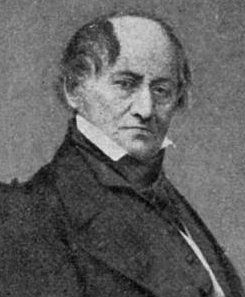
Friedrich Wieck |
||
|
Clara Wieck gives her premiere recital as a pianist at the Leipzig Gewandhaus concert hall. Together with a friend of hers, she plays the four-handed Variations on a March from Rossini’s Opera Moses by the contemporary composer Wilhelm Kalkbrenner and earns great applause. On November 8, Robert Schumann and a friend present for the first time and before a small audience his Variations on a Theme by Prince Louis Ferdinand of Prussia [G 2*] for four hands. The Huit Polonaises pour le pianoforte à quatre mains [G 1], written about the same time and first performed in December, again for a small circle of friends, earn much later the written comment by Johannes Brahms “From Schumann’s younger days. Certainly not for publication.” * The works named here and those given by numbers in square brackets refer to Robert Schumann – Thematisch bibliographisches Werkverzeichnis by Margit L. McCorkle, Henle-Verlag, München: 2002 The famous composer Franz Schubert dies in November at the young age of 31 years, possibly of typhoid fever. Robert Schumann is much distressed by the news. |
||
1829 |
Until March, Robert works on his first major composition, the Quatuor for Piano, in c minor [E 1], which will unfortunately remain unfinished. On May 11, RS moves to Heidelberg in order to attend the lectures of the famous professor of law Anton Justus Thibaut, as he pretends in a letter to his mother, but in reality because of the romantic gloriole of this university town. He does not mention that professor Thibaut has a great interest in music, that he is the author of the widely read book Über die Reinheit der Tonkunst (On the Purity of the Art of Music) published in 1825, and that he frequently entertains in his house with musical performances. Robert likes the town very much in the beginning but soon falls back into his old sluggish ways, records meticulously in his diary when he is drunk once again and is suffering from melancholy, also because he cannot shake the alcohol habit. However, he remains faithful to his music and continues his daily exercises and composition studies at the piano. Once again, his monthly cheque of 30 Taler, the interest of his inheritance, is not enough. Towards the end of the year, Robert Schumann goes on a trip to Switzerland and Italy, again financed by his mother after he raved about the South. He sees Basel, Bellinzona, Milano, Verona, and Venice, where he falls sick with an infection of the intestinal tract and has to wait for weeks until another cheque arrives that permits him to return to Heidelberg. He primes his mother and his guardian slowly and cautiously for the news that he’ll abandon law school: “Had I ever accomplished something in this world, it would have been in music.” |
|
1830 |
The rather private and taciturn Robert is catapulted into the “better” circles of Heidelberg society where his piano virtuosity is acclaimed after a mere two public performances. Unfortunately, he overdoes it with the piano playing and has to stop until summer because of a painful tendinitis of the third finger of his right hand. His true life had begun in this year, he’ll write later to his wife Clara. He composes a few short pieces for the piano that are soon published and are selling well, the so-called Abegg-Variations [op. 1] on the theme of a waltz; they are dedicated to a Pauline Comtesse d’Abegg (probably fictitious) whose family name is spelled out by the notes in the theme. He also creates the first few of the Papillons [op. 2], under the impression of Jean Paul’s novel Flegeljahre (Awkward Years of Adolescence).Friedrich Wieck gives Robert’s mother an enthusiastic evaluation of her son’s talents which would make of him, under certain conditions, one of the foremost pianists. After this, RS returns to Leipzig in November, resumes his piano lessons with Wieck and even moves into two rooms in his house. At just this time, eleven-year old Clara Wieck gives her first solo recital in the Gewandhaus concert hall with a daring program: a Rondo with orchestra by Kalkbrenner, the Variations brillantes by Henri Herz, a Quatuor by Czerny, a Romance by Friedrich Wieck and herself, and a few of her own variations to top it all off. Leipzig’s music-loving audience gives her hot applause, Robert gives her his admiration. |
|
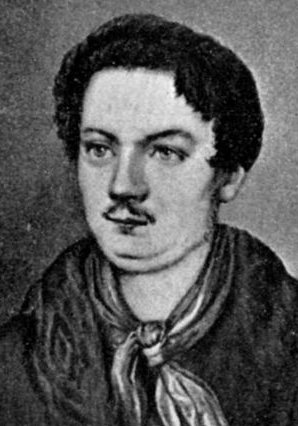
Robert Schumann as a young man, around 1831, after a lost portrait |
||
1831 |
Robert’s initial enthusiasm to follow the instructions of Friedrich Wieck ends soon because of the old man’s stubborn and narrow-minded attitude toward his young student who lacks self-discipline but is quite self-absorbed and opinionated. Schumann enjoys a pleasant success when his Abegg-Variations [op. 1] appear in print. Now Robert turns 21, is officially declared major and thus able to dispose of his inheritance as he wishes. Robert Schumann creates his fictitious Davidsbund (League of David) that fights for a poetic music and against mediocrity; he declares Berlioz, Chopin and Mozart members of this society. |
|
1832 |
In this time of gushing romanticism, Robert Schumann creates his fictitious Davidsbund (League of David) that fights for a poetic music and against mediocrity; he declares Berlioz, Chopin and Mozart members of this society. The first movement of Schumann’s Symphony in G minor [A 3] is presented in Zwickau, then the following November in Leipzig but has, according to the critics, flaws in development and instrumentation. Robert’s opus comes sixth on the program and all the attention and the applause go to Clara’s five virtuoso renditions. Robert’s right middle finger is now completely paralyzed and this ends his career as a concert pianist. He considers starting a music magazine and works feverishly on several smaller compositions most of which, however, remain mere sketches or are never finished. Apart from recurring bouts of melancholy that sometimes deepen to full-fledged depressions, he suffers from a painful genital ulcer; this shall lead some of his biographers to express the opinion that he had a primary syphilitic lesion, although neither the symptoms (pain!) nor the course of the affliction support this diagnosis. Towards the end of the year, Robert moves out of the rooms he rented in Friedrich Wieck’s house. |
|
1833 |
This year is marked by Robert Schumann’s budding love for Clara Wieck but also by the anguish of deepest melancholy following the death of his brother Julius, of one his sisters-in-law and of a close friend, and by an attack of malaria. He begins work on the symphonic Études en forme de variations [op. 13] which, however, he brings to completion only in the following year. |
|
1834 |
The first issue of Schumann’s Neue Leipziger Zeitschrift für Musik appears in April. It is directed primarily against the leading Allgemeine Musikalische Zeitung that is published by Breitkopf & Härtel in Leipzig, and against the “Philistine runts”. Robert’s publication is an immediate success, partly because he brings the old masters like Johann Sebastian Bach back to mind, partly because he champions Hector Berlioz and Frédérick Chopin of whom he says: “Tip your hats, gentlemen, a genius.” Alongside all the work brought on him by his periodical for which he often writes critical reports and reviews, he finds the time to continue, among others, the Symphonic etudes, [op. 13], to compose the Variationen über einen Sehnsuchtswalzer (= Variations on a Waltz of Longing) by Franz Schubert, [op. F 24], and the Piano Sonata in F sharp minor [op. 11], dedicated to Clara Wieck. In July, Robert falls in love with Ernestine von Fricken, a new student of Wieck’s who has the reputation of being totally without talent; they become engaged but he continues to flirt with Clara nevertheless. His Carnaval [op. 9], a cycle of small sketches for the piano, has autobiographical traits. It contains pieces that carry the names of Eusebius and Florestan, his double personae, others that hint at the name of Ernestine’s home town, and still others named, e.g., after Paganini and Chopin. The engagement with Ernestine von Fricken is soon dissolved again. |
|
1835 |
The relation between Clara and Robert is becoming clearer and more serious. They exchange romantic letters in secret and, in November, they kiss for the first time. |
|
1836 |
Robert Schumann’s beloved mother dies in February. Shortly before her death she had expressed the wish that Clara and Robert get married. |
|
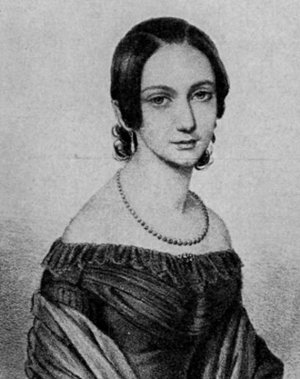
Clara Wieck, around 1837 |
||
|
Friedrich Wieck tries to drive the unreliable artiste out of his daughter’s mind. Of course he does not like to lose his dear daughter at such an early age to Schumann (and a major source of income with her). This is the time when she is about to become one of the greatest living virtuosi at the piano and when her own compositions are praised by Chopin, Liszt and Mendelssohn-Bartholdy. He forbids Robert to see her and threatens to shoot him. |
||
1837 |
On August 14, Clara Wieck and Robert Schumann become engaged. One month later, Robert asks her father formally for her hand but the request is refused. In October, the Wiecks travel to Dresden starting a concert tour that is to last seven months and will bring them also to Prague and Vienna. For Clara, this turns out to be a veritable triumphal parade although she is now 18 years old and no longer a wunderkind. For the time being, she is thus forced to respect her father’s ban to see Robert. There are really quite a few attractive and cultured men around, for instance the newly appointed director of the Gewandhaus orchestra in Leipzig, Felix Mendelssohn-Bartholdy, an excellent pianist and renowned composer who is only one year older than Robert. A bit of jealousy perturbs the fledgling friendship of RS and Felix. During the time he is separated from Clara, Robert writes the Fantasiestücke [op. 12] and the Fantasie in C-dur [op. 17], works through which he becomes widely known, even famous. All the same, Clara is worried and asks herself if Robert is in a position to offer her a “carefree situation”. Robert’s feelings of self-doubt and of guilt grow, and so does his general melancholy. The 18 Davidsbündlertänze (Dances of the League of David), [op. 6], are completed in September. Schumann calls them character pieces for piano, describes them as “dances of death, of gnomes and of graces”, and they again carry autobiographical traits. |
|
1838 |
In this year, Robert Schumann writes the Kreisleriana [op. 16], a cycle of eight fantasies for the piano that is one of his favorite compositions. The title refers to the principal character in a novel by E.T.A. Hoffmann who is Kapellmeister at the court of some prince and a wild, eccentric, misunderstood and deeply unhappy man. Schumann writes into these fantasies once more his own character — and a theme created by Clara Wieck appears in seven of the eight pieces. The Kreisleriana are dedicated to Frédéric Chopin who thanks Robert with his Ballade op. 38 in F major. In the Kinderszenen (Scenes from the Years as a Child), [op. 15], RS conjures up a life with Clara — as he writes her — but he dedicates them to her sister Marie Wieck. He travels to Vienna in September where he considers publishing his music magazine and where he’d like to move with Clara in order to escape the direct influence of her father. Nothing comes of that because the Censuring Board in Vienna does not grant him permission to publish his periodical with the lame argument that a foreigner could not be given such a license. |
|
1839 |
Clara is increasingly estranged from her father; after her return, in February, from a concert tour to Paris, she moves in with her mother in Berlin. Robert tries to obtain Friedrich Wieck’s consent for marriage by force and files a request to that effect with the Civil Court in Leipzig on July 15. Several attempts of a reconciliation fail and the court is not able to issue a verdict. During all this, Robert is maligned and harangued by the old man whose tirades are spread about widely and even appear in print. Under the pressure of these occurrences and the sudden death of his brother Eduard – who directed the publishing house founded by their father – Robert falls back into a paralyzing melancholy and complains for the first time about musical halluzinations. The Nachtstücke (Night Scenes) [op. 23] attest to the at times desperate mind of the composer. |
|
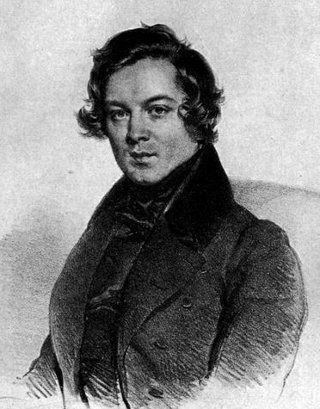
Robert Schumann |
||
|
RS provides the court with proof of his financial assets (among others, he states that he now has 443 subscribers for his periodical) and he points out proudly that the University of Leipzig has recently given him an honorary doctorate in recognition of his merits as a composer, critic, and publisher. Friedrich Wieck does not find anyone who would provide testimony that RS is suffering from chronic alcoholism. |
||
1840 |
On August 1, Robert Schumann and Clara Wieck obtain the consent for marriage from the Leipzig Court of Appeals. The wedding is celebrated on September 12, the day before Clara’s 21st birthday, in a small village church near Leipzig. In this memorable year, Robert Schumann writes more than 150 Lieder combined in cycles [see opa. no. 24, 25, 27, 29, 30, 31, 33, 34, 35, 36, 39 et al.], setting romantic poems by Hoffmann, Heine, Geibel, Eichendorff, Andersen, Rückert, Chamisso and others to music. Clara is also very satisfied with their work and enjoys one shining success after another on her concert tours; she is especially happy about the applause she receives when playing Robert’s works. Their finances are alright as well: Clara’s remuneration goes with her status as a celebrity and is that of a prima donna. But her mother in Berlin needs financial support and, unfortunately, her father is becoming ever more vicious. |
|
1841 |
RS’s life changes with the new responsibilities of matrimony. He becomes staid, level-headed, even disciplined, although his darker side shows up sometimes in agonizing episodes of gloom. He has great plans, ambitions to write orchestral music, hopes to revive the symphony. His Symphony No. 1, in B flat major [op. 38] is created very fast in the beginning of the year and is performed for the first time already in March, in the Leipzig Gewandhaus under the direction of Felix Mendelssohn-Bartholdy. Schumann calls it the Frühlingssinfonie (Spring Symphony) referring, in double-entendre, to the time of year and the turning point in his work. |
|
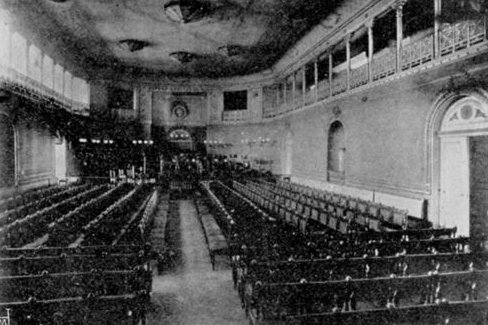
The Grand Hall in the Gewandhaus Leipzig, around 1850 |
||
|
The acceptance of his music by the public and especially Clara’s and Mendelssohn’s respect, even admiration incite Schumann to write several compositions for orchestra in rapid succession. He is hard at work already in April on op. 52, on what he calls a Symphonette, i.e. not really a symphony. Then comes the Fantasie für Klavier und Orchester, a piece loved by Clara, that he later uses as the first movement of his Piano Concerto in A minor [op. 54]. RS plans to use an oriental romance by the Irish poet Thomas Moore (1779-1852) as the libretto for an opera, but what comes out of this is a cycle of lyrical songs, Das Paradies und die Peri (Paradise and the Peri), [op. 50]. Peri is a fallen angel who is seeking admission to paradise but first has to be released of her sins. With this romantic composition Schumann gains international fame. Even Clara’s father now appears conciliatory and a kind of reserved friendship develops. In spite of their professional success, Clara’s and Robert’s combined income does not attain the amount they had hoped for. Therefore, Clara wants to resume her career as concert pianist as soon as possible. She gives a first (and, for the time being, last) recital under the name of Clara Schumann; her daughter Marie is born on September 1. In November, she goes on another concert tour. |
||
1842 |
The famous piano virtuoso presents her artistry in Northern Germany, then in Kopenhagen without Robert who pretends to have to work on his music periodical but feels again miserable and depressed. The bank account is replenished for a while but the marital harmony is suffering. |
|
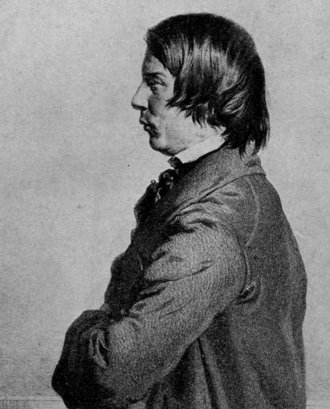
Robert Schumann at about 32 years of age. |
||
1843 |
The premiere performance, in January, of Robert Schumann’s Piano Quintet [op. 44] with Clara at the keyboard brings “friendly reverberations”. On the other hand, a visit by the noted French composer Hector Berlioz brings nothing good as the two men do not particularly care about each other’s work. The couple’s second daughter is born on April 25 and is given the name Elise. Robert receives a teaching appointment at the new Leipzig Konservatorium (= school of music) from its founder Felix Mendelssohn Bartholdy. The composer and music theorist Ignaz Moscheles and the well-known violin virtuoso Joseph Joachim are also won as teachers. Clara writes a series of love songs, her op. 13. Felix Mendelssohn persuades Robert to accompany Clara on a concert tour to Russia. |
|
1844 |
The trip to Russia via Berlin, Riga and St. Petersburg to Moscow is extremely arduous. Clara celebrates one triumph after another, except in Moscow where hardly anyone comes to her recital. Robert descends into deep melancholy and is not approachable. They take passage on a ship for the return trip through the Baltic although he is afraid of the sea. Financially, the tour is a great success. Robert’s health is deteriorating. His anxiety attacks return more often and he now fears that someone is out to kill him. He resigns from the position of editor-in-chief of the Neue Zeitschrift für Musik. The Schumanns move to Dresden temporarily, finally take a flat there for the winter months. The relocation appears to have a good effect on Robert’s disposition. One of the reasons given for having left Leipzig is the fact that their friend Felix Mendelssohn has accepted a call to Berlin by the King of Prussia. A new era begins for Robert Schumann: he has turned his back on Leipzig, has relinquished much of the responsibility for the music periodical he founded, he has found a new mode of expressing himself in his music and he is happy with the symphonic work he is writing now. Dresden does him good. The family decides to stay here. |
|
1845 |
Soon enough Robert complains about the ultra conservative Dresden molded by “Philistines”. His music is not much appreciated; all in all, contemporary works are rarely presented. He has hardly any contact to the Director of the Court Opera, Richard Wagner, because he does not like his music – with a few exceptions – and because he finds Wagner’s antisemitic tirades directed at his friend Mendelssohn disgusting. Wagner, in turn, calls Schumann an obnoxious person. Robert suffers greatly from his nervous affliction for nearly the first half of the year and hardly finds the time to write music. Clara is pregnant; the couple’s third daughter, Julie, is born on March 11. The financial situation is precarious again in spite of the fact that the family lives in, for them, modest circumstances. RS distances himself ever further from his earlier bent to romanticism. He studies the strict rules of the fugue, Bach’s Kunst der Fuge (The Art of Fugue) and composes Sechs Fugen über den Namen Bach (Six Fugues on the Name of Bach) [op. 60]. To his mind, he does not succeed in anything nor is he quite content with the pile of sketches for the Symphony No. 2 in C major [op. 61] written this year. |
|
1846 |
New blood in the family again: son Emil is born on February 8 (he’ll die already a year later). The family takes a prolonged vacation on the North Sea isle of Norderney where Robert’s health improves. Clara falls ill, possibly after another pregnancy comes to an end. In autumn, she travels to Vienna with works by Beethoven and Schumann on the program; she is cheered as usual but her recitals are not well attended. She performs in Prague, on the way home, where Robert Schumann’s Frühlingssymphonie [op. 38] and Piano Concerto [op. 54] are very well received. |
|
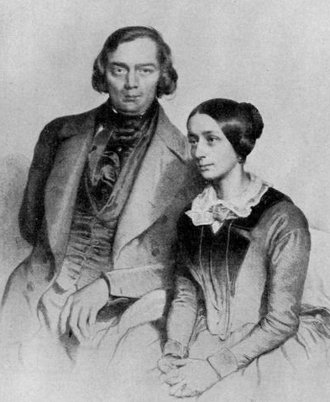
Clara and Robert Schumann in 1847. |
||
1847 |
With the help and advice from Felix Mendelssohn, RS completes the instrumentation of his Symphony in C major [op. 61]. He composes the beautiful Piano Trio No. 1, in D minor [op. 63] in his old romantic-lyrical style, much to Clara’s delight. Zwickau, Robert’s native town, honors her now famous son with a music festival at which, among other works, the Symphony in C major is played. A concert tour to Berlin is only a partial success: the musicians are disgruntled because they do not like that Robert conducts the orchestra; but then, Clara gives a shining performance with, amongst others, Robert’s Piano Quintet in E flat major [op. 44]. They meet Fanny Hensel, Felix Mendelssohn’s sister, who is a pianist and composer as is known only to a few friends. Fanny Hensel, née Mendelssohn, dies in May of a stroke, only 42 years of age. Sadly, her brother Felix Mendelssohn Bartholdy follows her on November 4, also after a stroke. He only reached the age of 38 years. |
|
1848 |
On January 20, Ludwig Schumann is born. Robert Schumann is deeply hurt when Saxony’s Royal Court Orchestra celebrates Dresden composers at its 300-year jubilee without mentioning him. The composer accepts the position of Musical Director of the Dresdner Liedertafel, a skilled and experienced choral society for men. In the beginning, he likes this type of work and writes several small pieces for the club. The Klavieralbum für die Jugend (Piano Album for the Young) [op. 68], is composed in summer. It contains more than 30 educational pieces in different degrees of difficulty and immediately becomes very popular. |
|
1849 |
Little is felt in bourgeois Dresden of the political unrest that has gripped several German states. Robert Schumann is enjoying good health and, in a particularly creative phase, writes many compositions that one of his biographers assigns to the genre of upmarket home music (e.g. op. 73, 74, 75, 79). Regrettably, they fail to become a financial success. Breitkopf & Härtel do not want to publish any more of Schumann’s works as they have already lost a considerable amount of money on them. The past year’s Klavieralbum [op. 68] is therefore printed and marketed by Schuberth in Hamburg. When the civil war reaches Dresden in May, the family flees to a small city in the vicinity. This turns out to be a good decision because Dresden is soon devastated while two Prussian regiments fight and then overpower the insurgents. Richard Wagner takes the side of the Republican revolters, delivers fiery speeches and goes on the list of wanted criminals. Schumann sympathizes also with the republicans but does not participate actively in the insurrection. He writes Four Marches on the Year 1849 [op. 76] in the spirit of the revolution but calmly continues with works of the “greatest peacefulness” as Clara writes in their common diary. The sum of his achievements in this year is extraordinary: McCorkle’s Index gives 45 completed compositions plus a series of sketches. In April, Robert gives up working with the Dresdner Liedertafel; he writes that the society does not show enough enthousiasm for its mission. With the argument that he could not earn enough money because of the unrest and because of his work on the opera Genoveva [op. 81], he asks his brother Carl, the proprietor of a printing company in Schneeberg near Dresden, for a loan. On July 16, Clara gives birth to Ferdinand Schumann. Robert’s older brother Carl dies in September. In October, Frédéric Chopin dies in Paris after having suffered from tuberculosis for nearly ten years. The financial situation finally improves for the Schumanns. The Klavieralbum earns a lot of money, Breitkopf & Härtel publishes a second Lieder-Album für die Jugend, [op. 79], in November; Robert’s total income for this year is greater than 1,200 Taler, more than four times the amount he made in 1848. Towards the end of the year, Robert receives a letter from Ferdinand Hiller, an old friend and at the time Kapellmeister (i.e. musical director) in Düsseldorf who just obtained an offer to come to Cologne and wants to exert his influence to have Schumann appointed as his successor. Initially, Robert is cool in view of his current success in Dresden. He asks Hiller the strange question if Düsseldorf really had a lunatic asylum as he has seen in an atlas; he ought to avoid all impressions that could deepen his melancholy, he writes. |
|
1850 |
Robert Schumann does not accept right away the offer to come to Düsseldorf because he is waiting for the premiere performance of his opera Genoveva [op. 81] in Leipzig, but probably also because he is still hoping to succeed Felix Mendelssohn-Bartholdy and be appointed Director of the Gewandhaus orchestra (Arthur Nikisch will follow Mendelssohn in this position). In the meantime, Clara gives recitals in Bremen, Hamburg and Berlin and earns an amount of money with these performances equivalent to what is to be Robert’s annual salary in Düsseldorf. In March, RS accepts the appointment as Musical Director in Düsseldorf; the move is planned for September. The first performance of Genoveva, in June, in the Leipzig municipal theater is a flop. The critics are polite but the bad opinions come through nevertheless. Robert suffers an attack of vertigo and does not utter a word for several days. The Schumanns are cordially received by the orchestra, the city’s administration and the music loving public of Düsseldorf. The city has a large concert hall with 1,300 seats. The first rehearsals are to Robert’s complete satisfaction. The first concert under his direction is given in October, works by Bach and Beethoven plus Clara’s presentation of the Piano Concerto in G minor by Mendelssohn. The applause for her is enthusiastic as usual. In this friendly atmosphere, Robert’s work advances much faster than in Dresden. He composes the Third Symphony, in E flat major [op. 97], “The Rhenish” in barely a month. It is a friendly, even cheerful work and will last as one of his greatest creations. |
|
1851 |
Unfortunately, the initial delight with the situation in Düsseldorf wears away rather fast as the public apparently does not understand Schumann’s new compositions (e.g. his Overture, [op. 100], for Schiller’s drama Die Braut von Messina) and because the orchestra does not like him as a conductor. He is the introverted perfectionist, soft spoken and hard to understand in his Saxon patois, who is annoyed by blabbering musicians, who is not particularly polite when he addresses the orchestra. Talking things out does not help, only brings unease. Schumann’s sentimental tale Der Rose Pilgerfahrt (The Rose’s Pilgrimage), [op. 112] is performed in June but does not catch on. Shortly thereafter, the family takes two weeks vacation in Switzerland, a trip that brings them, in part by train, via Heidelberg and Basel to Chamonix. Robert is feeling very good for a change. Back in Düsseldorf, the quarrel with the choir and the orchestra starts up again. The Board of Directors does not want to break Schumann’s contract; a solution of the crisis is not to be expected. Schumann works with great zeal through all this hassle and writes several important compositions in the second half of the year like the Piano Trio in G minor [op. 110] and a number of ballads for solo voices, choir and orchestra to poems by Ludwig Uhland. The seventh child of the Schumanns, daughter Eugenie, is born on December 1. |
|
1852 |
Robert Schumann complains about acoustic hallucinations and has trouble speaking. He is writing sacred music for the first time, the Missa sacra in C minor [op. 147] and the Requiem in D flat major [op. 148]. No publisher is interested in these works during Schumann’s lifetime. Robert travels with Clara to Leipzig in March in spite of his ill health, to hear the Rhenish Symphony [op.97] played to raging applause. Trips like this prop up his self-esteem as the couple is celebrated everywhere, finds everywhere more respect and admiration than in Düsseldorf. Because of his severe nervous distress (as Robert himself writes), the Schumanns travel to Scheveningen, a health spa in Holland. |
|
1853 |
Robert Schumann’s Festouvertüre mit Gesang über das Rheinweinlied (Festive Overture on the Rheinweinlied, with Orchestra and Chorus), [op. 123], is savaged by the critics. He has not much to enjoy during this time but at least he feels relatively good until July 30: he suffers a sudden physical weakness with vertigo, possibly a minor stroke. By September, he is well enough again to make music with Joseph Joachim, the violin virtuoso who is visiting the Schumanns. On the recommendation of Joseph Joachim, the young pianist and composer Johannes Brahms from Hamburg introduces himself in September; he is only 20 years old. Robert and Clara are very much impressed with his piano playing, especially with his talent to improvise, but also with the appearance of this handsome man with the long blond hair. In an article for the Neue Zeitschrift für Musik, Robert writes that Brahms has a “higher calling”. Brahms is clarly in love with Clara, she is fond of him at the least. |
|
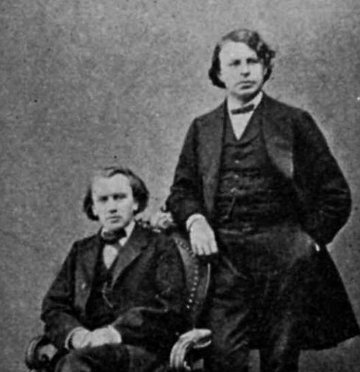
The friends of Robert Schumann, Johannes Brahms and |
||
|
Johannes Brahms stays in Düsseldorf for about a month and he writes with Robert and another composer friend, Albert Dietrich, a violin sonata as a surprise for Joseph Joachim. The theme is based on the notes F-A-E according to Joachim’s motto Frei aber einsam (Free but alone). Dietrich writes the first movement, Schumann the 2nd and the 4th, Brahms the 3rd. When they play the sonata for a small group of friends, Joachim recognizes immediately the authors of the movements by their styles. In October, Schumann uses his two movements in the Violin Sonata No. 3, in A minor [WoO 2*]. * The acronym WoO comes from the German “Werk ohne Opuszahl” (= work without opus number) and refers to compositions that were either not numbered by Schumann himself or not published in his lifetime. |
||
|
The tense relationship of conductor, choir and orchestra comes to a point when the directorate decides that Schumann is to conduct only his own works, his assistant all others. Robert resigns his position as Musical Director effective the 31st of October of the following year. In barely two weeks in September, Robert Schumann composes his last major work, the Concerto for Violin and Orchestra in D minor [WoO 1] and dedicates it to an old friend from Leipzig, the violinist Ferdinand David. Joseph Joachim finds that especially the last movement is terribly hard to play. A concert tour through the Netherlands lasts two months, until Christmas. Clara shows off her unusually extensive repertoire of works by Beethoven, Schumann, Chopin, Mendelssohn and others. She is again expecting but possesses admirable strength and energy. The trip is one sole triumph. |
||
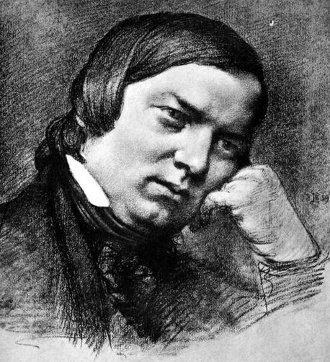
Robert Schumann towards the end of his life. |
||
1854 |
This is the fateful year in Schumann’s life. In February, he suffers from a painful “affliction of hearing”: at times he hears only a single high-pitched sound (the so-called tinnitus), at times he is tortured by hallucinations that take the form of orchestral music, melodious and agreeable in the beginning but degenerating into dissonance. On February 26, Robert decides to commit himself into one of the psychiatric institutions he fears so much and he starts packing the papers he wants to take along. Clara hires a male nurse who is to watch him constantly. On February 27, a rainy Monday after carnival, Robert Schumann leaves the apartment in an unsupervised moment at around 2:00 p.m., walks in slippers to the old bridge across the Rhine river (a floating bridge) to about the middle, throws his wedding band over the guard rail and then hurls himself into the water. He is saved by two fishermen who found his demeanor peculiar. |
|
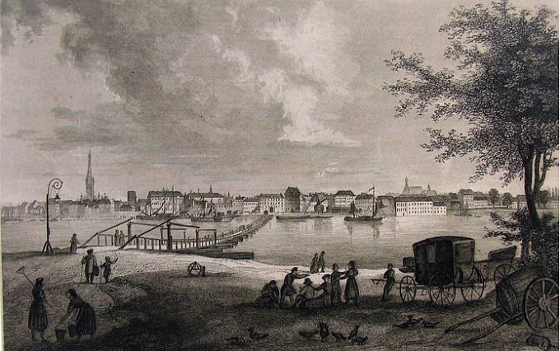
The old bridge across the river Rhine in Düsseldorf in 1839 |
||
|
On March 4, Robert Schumann is brought to the Psychiatric Sanatorium in Bonn-Endenich (near Cologne), a private clinic owned and directed by the psychiatrist Dr. Franz Richarz, rather expensive at 50 Taler a month. He is watched by guards at all times but can move freely on the premises, use the library, play the piano in the music room and take walks in the park around the building. RS is visited in Endenich by many of his friends but not by his wife. Clara supposedly follows the advice of the physicians who fear that his state might turn for the worse. He occupies himself with his Dichtergarten (Poetic Garden), a literary anthology of music, and he writes his wife longing letters. He receives news of the birth of his son Felix on June 11 from his wife’s letter; he shall never see him. In September, Clara resumes her concert tours to earn money for the family. Notes and articles concerning her are removed from the newspapers before Robert sees them. Robert has sometimes, rarely, lucid moments, even days and he works then on new music as, for instance, a piano part for Paganini’s Caprices for Violin. His therapy consists of morphine, quinine and digestive pills, otherwise cold baths, at the time the usual treatment. |
||
1855 |
Robert Schumann’s illness worsens. Dr. Richarz’s diagnosis is decriptive, “melancholy with delusions”. The patient is agitated, rejects food, loses weight and contact with reality. He now occupies himself with writing an alphabetical list of the names of cities and towns, using an atlas brought by Brahms. |
|
1856 |
Following notification by telegram from Dr. Richarz that Robert is fading away, Clara Schumann comes to see her husband in the clinic for the first time on July 27 but he does no longer recognize her. Since his hospitalization in Endenich on March 4, 1854, until his death on July 29, 1856, Robert Schumann has not seen his children once. He is buried on July 31 in Bonn’s Old Cemetary. |
|
|
Clara Wieck-Schumann dies in 1896, 77 years of age. Several of Robert Schumann’s biographers write that the composer had possibly or probably suffered from syphilis since his student days in Leipzig and that his nervous disorder constituted the fourth and last phase of this chronic disease. A recent meticulouos review of the medical record and of the autopsy report by medical specialists in the pertinent disciplines does not support this allegation. The assertion that Schumann has fallen victim of a venereal disease should therefore not be further diffused.
|
||
Recommended reading |
||
|
|
Martin Demmler: Robert Schumann. Reclam Verlag, Leipzig 2006 (in German) Wolfgang Held: Clara und Robert Schumann. Insel Verlag, Frankfurt, 2001 (in German) Barbara Meier: Robert Schumann. Rowohlt Taschenbuch, Reinbek, 1995 (in German) Bernhard R. Appel (ed.): Robert Schumann in Endenich (1854-1856): Krankenakten, Briefzeugnisse und zeitgenössische Berichte. Schott, Mainz: 2006 (in German) Eric F. Jensen: Schumann. Oxford University Press: 2004 (in English) Margit McCorkle: Robert Schumann. Thematisch-Bibliographisches Werkverzeichnis. G. Henle Verlag, München, 2003 (in German) |
|
|
I wish to express my heartfelt thanks to the ladies and gentlemen of the Robert-Schumann House in Zwickau/Germany for the generous access to their collection of Clara's and Robert's works.
|
||
